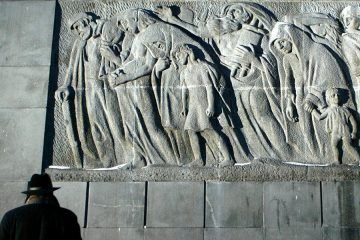Eva Botkin-Kowacki in The Christian Science Monitor:
 To some witnesses, it simply didn’t make sense. “This is really an irrational phenomenon,” wrote the Polish historian Emanuel Ringelblum, in notes found after his execution by the Gestapo. “There’s no explaining it rationally.” It was November 1941 in the Warsaw Ghetto, the sliver of Poland’s capital that the Nazi occupying government had transformed into a squalid holding pen for the area’s Jews, Romani, and others deemed undesirable. Typhus had raged through the community all through the summer and early autumn. But then, just as infection rates were expected to have skyrocketed as winter approached, cases fell dramatically. “I heard this from the apothecaries, and the same thing from doctors and the hospital,” Ringelblum wrote that month. “The epidemic rate has fallen some 40 per cent.”
To some witnesses, it simply didn’t make sense. “This is really an irrational phenomenon,” wrote the Polish historian Emanuel Ringelblum, in notes found after his execution by the Gestapo. “There’s no explaining it rationally.” It was November 1941 in the Warsaw Ghetto, the sliver of Poland’s capital that the Nazi occupying government had transformed into a squalid holding pen for the area’s Jews, Romani, and others deemed undesirable. Typhus had raged through the community all through the summer and early autumn. But then, just as infection rates were expected to have skyrocketed as winter approached, cases fell dramatically. “I heard this from the apothecaries, and the same thing from doctors and the hospital,” Ringelblum wrote that month. “The epidemic rate has fallen some 40 per cent.”
The Warsaw Ghetto should have been an optimal site for an outbreak. More than 450,000 mostly Jewish inmates were crammed into 1.3 square miles, making for a population density between 5 and 10 times that of today’s busiest cities. Nazi authorities deliberately kept resources from entering the area, all the while using fear of disease in anti-Semitic party propaganda. Nevertheless, typhus rates in the Warsaw Ghetto were plummeting.
The only explanation, according to research published today in the journal Science Advances, is that the inmates did it themselves, by sheltering in place, promoting and enforcing hygiene, and practicing social distancing. This remarkable story of an oppressed community rallying together to combat a public health crisis holds obvious implications for today, as the novel coronavirus pandemic continues to claim thousands of lives around the world daily and debilitate national economies. “It’s one of the great medical stories of all time,” says Howard Markel, the University of Michigan physician and medical historian who coined the term “flatten the curve” in relation to COVID-19. “We should take heart and inspiration from the courage, bravery, and unity of doctors, nurses, and patients alike to combat an infectious foe. We need to do that today, and they did it under much more dire circumstances.”
More here.
